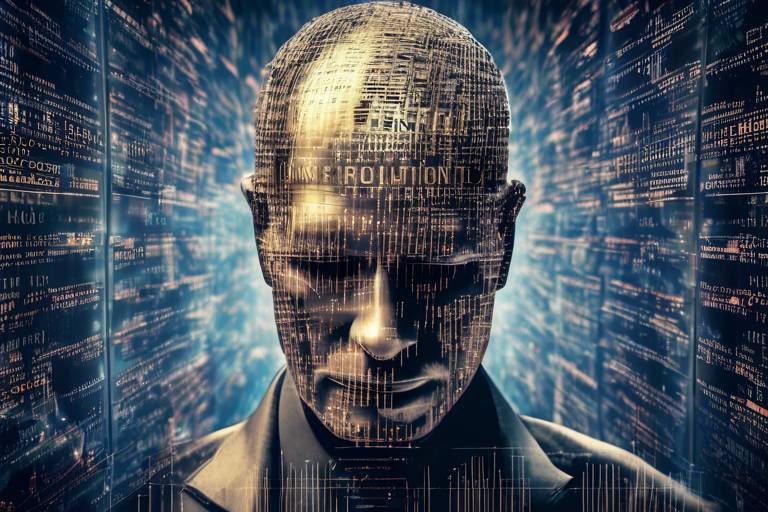Artificial Intelligence in Cybersecurity: Friend or Foe?
In an era where technology is advancing at lightning speed, the role of artificial intelligence (AI) in cybersecurity has become a hot topic of discussion. With the increasing sophistication of cyber threats, organizations are turning to AI as their digital knight in shining armor. But is AI truly a friend in the battle against cybercrime, or does it pose its own set of challenges that could turn it into a foe? This article delves into the dual nature of AI in cybersecurity, exploring its benefits, challenges, and the ethical considerations that come into play.
As cyber threats evolve, so do the tools we use to combat them. AI technologies are being seamlessly integrated into security systems, enhancing our ability to detect and respond to threats. Imagine AI as a vigilant guard dog, constantly on the lookout for intruders, analyzing patterns, and learning from every encounter. This integration not only improves the efficiency of threat detection but also allows organizations to stay one step ahead of cybercriminals. From machine learning algorithms that sift through vast amounts of data to neural networks that predict potential breaches, AI is redefining what it means to be secure in the digital age.
So, what exactly does AI bring to the table in the realm of cybersecurity? The advantages are numerous and significant. First and foremost, AI offers faster threat detection. With its ability to analyze data at unprecedented speeds, AI can identify potential threats before they escalate into full-blown attacks. This capability is akin to having a supercharged security system that never sleeps. Moreover, AI enables predictive analytics, allowing organizations to anticipate and mitigate risks before they materialize. Imagine being able to see into the future and prepare for cyber threats before they even knock on your door!
One of the standout features of AI in cybersecurity is its enhanced threat detection capabilities. By leveraging machine learning algorithms, AI can sift through enormous datasets to identify patterns that may indicate a cyber threat. This is where AI truly shines, transforming raw data into actionable insights. For organizations, this means a significant reduction in the time it takes to detect and respond to threats, ultimately leading to a more secure environment.
Understanding user behavior is another key component of AI's role in cybersecurity. By monitoring and analyzing how users interact with systems, AI can detect anomalies that may signify a security breach. Think of it as having a personal bodyguard who knows your habits well enough to spot when something feels off. This behavioral analysis not only enhances security measures but also helps organizations tailor their responses to specific threats, making them more effective.
In the world of cybersecurity, time is of the essence. AI systems can provide immediate responses to threats, minimizing damage and potential data loss. This real-time threat mitigation is crucial, especially in an age where cyber attacks can happen in the blink of an eye. With AI as a partner, organizations can act swiftly and decisively, reducing the risk of a successful breach.
However, it’s not all sunshine and rainbows. Despite its benefits, AI also presents several challenges. One major concern is the occurrence of false positives, where legitimate activities are flagged as threats. This can lead to unnecessary panic and resource allocation. Additionally, AI's effectiveness is heavily reliant on the quality of the data it processes. Poor data quality can result in misguided decisions and actions, turning AI from a trusty ally into a potential adversary.
As we embrace AI in cybersecurity, it’s essential to consider the ethical implications of its use. One pressing concern is privacy. AI's ability to analyze personal data can lead to privacy violations, raising questions about the balance between security needs and individual rights. How do we protect our data without compromising our privacy?
In a world where data is the new gold, the stakes are high. Organizations must navigate the fine line between leveraging AI for security and respecting the privacy of individuals. It’s a delicate dance, and one misstep could lead to significant backlash from the public.
Another ethical challenge is algorithmic bias. AI systems can inadvertently perpetuate biases present in their training data, leading to unfair treatment or oversight in cybersecurity efforts. Addressing these issues is not just a technical challenge; it’s a moral imperative that organizations must prioritize to ensure equitable security measures.
- Is AI more effective than traditional cybersecurity methods?
AI can significantly enhance threat detection and response times compared to traditional methods, making it a powerful tool in cybersecurity. - What are the risks of using AI in cybersecurity?
Risks include false positives, reliance on data quality, and ethical concerns regarding privacy and bias. - How can organizations ensure ethical AI use?
Organizations should implement robust data governance policies, regularly audit their AI systems, and prioritize transparency in their AI practices.

The Rise of AI in Cybersecurity
In today's digital landscape, the **rise of artificial intelligence (AI)** in cybersecurity is nothing short of revolutionary. As cyber threats become increasingly sophisticated and pervasive, traditional security measures often fall short. This is where AI steps in as a game-changer. Imagine trying to find a needle in a haystack; now, picture having a highly trained robot that can sift through that haystack in seconds. That's the kind of efficiency AI brings to the table in the realm of cybersecurity.
AI technologies are being seamlessly integrated into security systems, transforming the way organizations detect, respond to, and mitigate threats. From machine learning algorithms that can learn and adapt to new threats, to advanced analytics that can process vast amounts of data in real-time, AI is enhancing our ability to protect sensitive information. For instance, companies are now using AI to monitor network traffic, identifying unusual patterns that could indicate a breach before it escalates into a full-blown attack.
Moreover, the integration of AI in cybersecurity is not just about detection; it's also about **response**. The speed at which AI can analyze data and respond to threats is unprecedented. In many cases, AI systems can react to potential threats faster than a human ever could, allowing for immediate containment measures. This rapid response capability is crucial in minimizing damage and protecting valuable assets. With cyberattacks becoming more common, organizations are increasingly relying on AI to bolster their defenses.
To illustrate the impact of AI in cybersecurity, consider the following table that showcases various AI applications and their benefits:
| AI Application | Benefits |
|---|---|
| Threat Intelligence | Real-time analysis of emerging threats |
| Automated Incident Response | Immediate action against detected threats |
| Predictive Analytics | Forecasting potential vulnerabilities |
| Fraud Detection | Identifying fraudulent activities quickly |
As we delve deeper into the **benefits of AI in cyber defense**, it's essential to recognize that while AI serves as a powerful ally, its implementation is not without challenges. The balance between leveraging AI's capabilities and understanding its limitations is crucial for organizations aiming to stay ahead of cyber threats. As we navigate this landscape, the question remains: will AI ultimately be our greatest ally in the fight against cyber crime, or could it become a foe in its own right?
- What is the main role of AI in cybersecurity? AI enhances threat detection and response times, improving overall security measures.
- Can AI completely replace human cybersecurity experts? No, while AI can automate many processes, human expertise is still essential for strategic decision-making.
- What are the risks associated with AI in cybersecurity? Risks include false positives, reliance on data quality, and ethical concerns regarding privacy.

Benefits of AI in Cyber Defense
In today's digital landscape, the integration of artificial intelligence (AI) into cybersecurity is not just a trend; it’s becoming a necessity. As cyber threats grow in sophistication, the advantages that AI brings to the table are both compelling and transformative. One of the most significant benefits of AI in cyber defense is its ability to detect threats faster than traditional methods. While human analysts may take hours or even days to identify a breach, AI systems can process vast amounts of data in real time, allowing organizations to respond swiftly and effectively.
Another key benefit is the power of predictive analytics. AI can analyze historical data to forecast potential threats before they materialize. Imagine having a crystal ball that not only identifies existing vulnerabilities but also predicts where future attacks might occur. This proactive approach enables organizations to fortify their defenses ahead of time, rather than waiting for an attack to happen. In fact, many companies are now leveraging AI to create a dynamic security posture that evolves with emerging threats.
Furthermore, the automation capabilities of AI streamline security operations significantly. By automating routine tasks such as monitoring network traffic, scanning for vulnerabilities, and responding to alerts, AI allows cybersecurity professionals to focus on more complex issues. This increased efficiency not only enhances the overall security framework but also reduces the workload on human teams, freeing them up to engage in strategic planning and incident response.
To illustrate these benefits further, consider the following table that summarizes the primary advantages of AI in cyber defense:
| Benefit | Description |
|---|---|
| Faster Threat Detection | AI systems can analyze data in real time, identifying threats much quicker than human analysts. |
| Predictive Analytics | AI forecasts potential threats based on historical data, allowing for proactive defense measures. |
| Automated Responses | Automation of routine tasks improves efficiency and allows human analysts to focus on complex issues. |
Moreover, AI excels in behavioral analysis. By learning the typical behavior patterns of users, AI can detect anomalies that may indicate a security breach. For instance, if an employee suddenly accesses sensitive data at an unusual hour, the system can flag this behavior for further investigation. This capability not only enhances security measures but also helps organizations understand their vulnerabilities better.
Finally, the real-time response provided by AI systems is invaluable in minimizing damage during an incident. When a threat is detected, AI can initiate immediate countermeasures, such as isolating affected systems or blocking suspicious IP addresses. This rapid response can significantly reduce the potential impact of a cyber attack, protecting both sensitive data and organizational reputation.
In summary, the benefits of AI in cyber defense are multifaceted and profound. From faster threat detection and predictive capabilities to behavioral analysis and real-time responses, AI is proving to be a formidable ally in the ongoing battle against cyber threats. Organizations that embrace these technologies are not just enhancing their security posture; they are positioning themselves to thrive in an increasingly complex digital world.
- How does AI improve threat detection? AI analyzes large data sets quickly to identify patterns that indicate potential threats, enabling faster responses.
- Can AI predict future cyber threats? Yes, AI uses historical data to forecast potential threats, allowing organizations to prepare in advance.
- What role does automation play in cybersecurity? Automation helps streamline routine tasks, allowing cybersecurity professionals to focus on more complex issues.
- Are there any risks associated with using AI in cybersecurity? Yes, while AI offers many benefits, challenges such as false positives and reliance on data quality must be managed.

Enhanced Threat Detection
In the ever-evolving landscape of cybersecurity, has emerged as a game-changer, primarily driven by the capabilities of artificial intelligence (AI). Imagine trying to find a needle in a haystack—this is akin to the challenge cybersecurity professionals face when sifting through colossal amounts of data to pinpoint potential threats. Fortunately, AI acts as a magnifying glass, allowing organizations to scrutinize vast datasets with unmatched speed and precision. By harnessing machine learning algorithms, AI systems can detect patterns that may go unnoticed by the human eye.
One of the most remarkable aspects of AI in threat detection is its ability to learn and adapt. As it processes more data, the AI becomes increasingly proficient at identifying anomalies that signify a security breach. This is akin to training a dog; the more you teach it, the better it becomes at recognizing commands. In cybersecurity, this translates to AI systems evolving to recognize new threats as they emerge, providing organizations with a proactive defense mechanism.
To illustrate the effectiveness of AI in threat detection, consider the following table that compares traditional methods with AI-enhanced techniques:
| Feature | Traditional Methods | AI-Enhanced Methods |
|---|---|---|
| Data Processing Speed | Slow | Fast |
| Pattern Recognition | Manual | Automated |
| Adaptability to New Threats | Limited | High |
| False Positive Rate | Higher | Lower |
As shown in the table, AI-enhanced methods outperform traditional techniques in several key areas, making them indispensable in contemporary cybersecurity strategies. However, it's essential to recognize that while AI can significantly improve threat detection, it is not infallible. The reliance on historical data means that if a new type of threat emerges that the AI has not encountered before, it may struggle to identify it. This highlights the importance of combining AI capabilities with human expertise to create a robust cybersecurity framework.
Moreover, the integration of AI in threat detection also allows for behavioral analysis, which is crucial in identifying unusual activity that could indicate a breach. For instance, if an employee who typically logs in from one geographic location suddenly accesses the system from a different country, AI can flag this behavior for further investigation. This level of scrutiny is vital for organizations aiming to stay one step ahead of cybercriminals.
In conclusion, enhanced threat detection through AI is not just a technological advancement; it's a necessity in today's digital world. As cyber threats become more sophisticated, the ability of AI to analyze data quickly and accurately will be a cornerstone in safeguarding sensitive information and maintaining organizational integrity.

Behavioral Analysis
In the ever-evolving landscape of cybersecurity, emerges as a powerful tool that leverages artificial intelligence to enhance security measures. Imagine having a vigilant security guard who not only watches for intruders but also knows the usual patterns of behavior of everyone in the building. This is essentially what behavioral analysis does in the cyber realm—it establishes a baseline of normal user behavior and then monitors for any deviations that could signal a potential security breach.
By employing machine learning algorithms, AI systems can sift through mountains of data to identify anomalies. This means that if a user suddenly accesses sensitive information at an odd hour or from an unusual location, the system can flag this activity for further investigation. The beauty of this approach lies in its proactive nature; instead of waiting for a breach to occur, organizations can detect and mitigate threats before they escalate.
Furthermore, behavioral analysis is not just about spotting the bad guys; it’s also about understanding the good ones. By analyzing patterns such as login times, typical access points, and even typing rhythms, AI can create a comprehensive profile of legitimate users. This not only helps in identifying potential threats but also minimizes the chances of false positives—those annoying alerts that often turn out to be nothing more than a harmless anomaly.
However, it’s important to note that while behavioral analysis is a significant advancement in cybersecurity, it’s not without its challenges. For instance, it requires vast amounts of high-quality data to train the algorithms effectively. If the data is biased or incomplete, the system may produce inaccurate results, leading to either missed threats or unnecessary alarm. Moreover, as organizations increasingly rely on this technology, they must also consider the ethical implications, such as privacy concerns and the potential for misuse of personal data.
In conclusion, behavioral analysis stands at the forefront of AI-driven cybersecurity innovations. It offers a dynamic and proactive approach to threat detection, allowing organizations to stay one step ahead of cybercriminals. However, as with any powerful tool, it must be wielded with care, ensuring that the balance between security and privacy is maintained.
- What is behavioral analysis in cybersecurity?
Behavioral analysis involves monitoring user behavior to detect anomalies that may indicate a security threat, enhancing the overall security posture of an organization.
- How does AI improve behavioral analysis?
AI enhances behavioral analysis by using machine learning algorithms to analyze vast amounts of data, identifying patterns and deviations that could signify potential threats.
- What are the main challenges of using behavioral analysis?
Key challenges include the need for high-quality data, the risk of false positives, and ethical concerns surrounding user privacy.

Real-Time Response
In today's fast-paced digital landscape, the ability to respond to cyber threats in real-time is not just an advantage—it's a necessity. Imagine a fire alarm that not only alerts you but also automatically dials the fire department and unlocks the doors for them. That's the kind of efficiency that powered by artificial intelligence (AI) brings to cybersecurity. With cyber threats evolving at an unprecedented rate, organizations can't afford to wait for human intervention to mitigate risks. AI systems are designed to monitor networks continuously, analyzing data streams to detect anomalies that could signify a breach.
What makes real-time response so revolutionary is its speed. Traditional security measures often involve delayed reactions, where alerts are generated and then handed off to human analysts for further investigation. This can lead to critical windows of vulnerability. In contrast, AI can initiate an immediate response upon detection of suspicious activity. For example, if an unauthorized user attempts to access sensitive data, AI can automatically isolate the affected system, thereby containing the threat before it escalates. This kind of swift action can mean the difference between a minor incident and a full-blown data breach.
Moreover, the integration of AI in real-time response not only enhances security but also optimizes resource allocation. By automating the initial response to threats, organizations can free up their cybersecurity teams to focus on more complex issues that require human insight and expertise. This is particularly crucial in a world where the cybersecurity talent pool is limited, and the demand for skilled professionals is skyrocketing.
To illustrate the impact of AI on real-time responses, consider the following table that outlines the differences between traditional security measures and AI-driven solutions:
| Aspect | Traditional Security Measures | AI-Driven Security Solutions |
|---|---|---|
| Response Time | Minutes to hours | Seconds |
| Human Intervention | Required for most actions | Minimal; automated responses |
| Scalability | Limited by workforce | Highly scalable with machine learning |
| Resource Allocation | Focus on routine monitoring | Focus on complex threats and strategy |
While the benefits of real-time response are clear, it’s essential to remember that AI is not infallible. There is still a need for human oversight to ensure that the automated systems are functioning correctly and to handle any edge cases that the AI might not be trained to recognize. However, the combination of AI's speed and human expertise creates a powerful defense mechanism against cyber threats.
In conclusion, the real-time response capabilities of AI are transforming the cybersecurity landscape. By enabling organizations to react instantly to potential threats, AI not only enhances security but also allows teams to work more efficiently. As we continue to navigate the complexities of the cyber world, embracing AI's potential will be crucial in staying one step ahead of cybercriminals.
- What is real-time response in cybersecurity? Real-time response refers to the immediate actions taken by security systems to mitigate threats as they are detected, minimizing potential damage.
- How does AI improve real-time response? AI enhances real-time response by continuously monitoring data, identifying anomalies, and automatically executing predefined actions without human intervention.
- Are AI-driven responses always accurate? While AI significantly improves response times, it can still produce false positives. Human oversight is essential to validate actions taken by AI systems.
- What role do humans play in AI-driven cybersecurity? Humans are crucial for overseeing AI systems, providing context, and handling complex threats that require nuanced understanding beyond AI's capabilities.

Challenges of AI in Cybersecurity
While the integration of artificial intelligence in cybersecurity brings a plethora of advantages, it is not without its challenges. One of the most significant issues is the occurrence of false positives. Imagine a fire alarm that goes off every time someone cooks a meal; it becomes a nuisance and ultimately leads to alarm fatigue. In cybersecurity, when AI systems incorrectly identify benign activities as threats, it can overwhelm security teams and divert their attention from genuine threats. This can create a scenario where real risks are overlooked, which could have catastrophic consequences.
Another challenge is the reliance on data quality. AI systems learn from the data they are trained on. If that data is flawed or biased, the AI's performance will be compromised. For instance, if an AI model is trained primarily on data from one demographic, it may not accurately detect threats in a more diverse environment. This scenario is akin to teaching a dog tricks using only one type of treat; the dog may only respond to that treat and ignore others, leading to a lack of adaptability in different situations.
Moreover, the rapid evolution of cyber threats poses a constant challenge for AI systems. Cybercriminals are always on the lookout for new vulnerabilities and methods to bypass security measures. The speed at which these threats evolve can outpace the ability of AI systems to adapt. This creates a cat-and-mouse game where AI must continuously learn and evolve, which requires significant resources and time. Organizations must invest in ongoing training and updates for their AI systems to ensure they remain effective against emerging threats.
In addition to these technical challenges, there are also organizational hurdles. Companies may face resistance to change from employees who are accustomed to traditional cybersecurity measures. Implementing AI requires a shift in mindset, and not everyone may be on board with this transition. Additionally, there may be a lack of understanding regarding how AI works, leading to skepticism and reluctance to trust AI-driven solutions.
Finally, it is crucial to consider the ethical implications of AI in cybersecurity. As organizations increasingly rely on AI to make decisions, questions arise about accountability and transparency. If an AI system makes a mistake that leads to a data breach, who is responsible? This uncertainty can create a barrier to AI adoption, as organizations may fear the potential fallout from missteps.
In summary, while AI has the potential to revolutionize cybersecurity, organizations must navigate a complex landscape of challenges. From false positives and data quality issues to the need for ongoing adaptation and ethical considerations, these challenges require careful attention and strategic planning. Embracing AI in cybersecurity isn't just about leveraging technology; it's about understanding and addressing the multifaceted challenges that come with it.
- What are false positives in AI cybersecurity? False positives occur when AI mistakenly identifies a legitimate action as a security threat, leading to unnecessary alerts and potential distraction from real threats.
- How does data quality affect AI performance? AI systems rely on high-quality, unbiased data for training. Poor data can lead to ineffective threat detection and response.
- What ethical concerns are associated with AI in cybersecurity? Key ethical concerns include accountability for AI decisions and potential privacy violations when analyzing personal data.
- How can organizations overcome resistance to AI adoption? Education and training about AI's benefits and capabilities can help alleviate skepticism and encourage a smoother transition.

Ethical Considerations in AI Use
As we delve deeper into the realm of artificial intelligence (AI) in cybersecurity, it becomes increasingly clear that the ethical implications of its use cannot be overlooked. The rapid integration of AI technologies into security frameworks raises significant questions about privacy, accountability, and the potential for unintended consequences. It's like walking a tightrope; on one side, we have the promise of enhanced security, and on the other, the risks of infringing on individual rights. So, how do we strike that delicate balance?
One of the most pressing ethical concerns revolves around privacy. AI systems often rely on vast amounts of personal data to function effectively. This data can include sensitive information about individuals, which raises the question: at what point does the need for security infringe upon our right to privacy? For instance, consider a scenario where an AI-driven system is monitoring user behavior to detect anomalies. While this can enhance security, it also means that the system is constantly collecting and analyzing personal data. This creates a potential risk of privacy violations, where innocent actions could be misinterpreted as suspicious behavior, leading to unwarranted scrutiny of individuals.
Furthermore, there's the issue of algorithmic bias. AI systems are only as good as the data they're trained on. If the training data contains biases—whether conscious or unconscious—those biases can be perpetuated in the AI's decision-making processes. This is particularly concerning in cybersecurity, where biased algorithms could lead to disproportionate targeting of specific groups or individuals. For example, if an AI system is trained predominantly on data from one demographic, it may fail to recognize legitimate behaviors from others, leading to an increase in false positives or missed threats. The implications of this are profound, as it not only undermines the effectiveness of cybersecurity measures but also raises ethical questions about fairness and equality in technology.
To navigate these ethical waters, organizations must implement robust frameworks that prioritize transparency and accountability in their use of AI. This includes regularly auditing AI systems for biases, ensuring that data collection practices respect individual privacy rights, and being clear about how AI technologies are used in security contexts. Additionally, fostering an open dialogue about the ethical implications of AI can help build trust with the public, ensuring that the deployment of these technologies is not only effective but also responsible.
In conclusion, while AI holds tremendous potential for enhancing cybersecurity, it also presents significant ethical challenges that must be addressed. By prioritizing privacy and fairness, organizations can harness the power of AI while safeguarding the rights of individuals. It's a complex landscape, but with thoughtful consideration and ethical practices, we can work towards a future where AI serves as a true ally in the fight against cyber threats.
- What are the main ethical concerns regarding AI in cybersecurity? The primary concerns include privacy violations and algorithmic bias, which can lead to unfair treatment of individuals and groups.
- How can organizations ensure ethical use of AI? Organizations can implement transparency measures, regularly audit AI systems for biases, and engage in open discussions about ethical implications.
- What is algorithmic bias? Algorithmic bias refers to the tendency of AI systems to reflect the biases present in their training data, which can lead to unfair outcomes in decision-making.

Privacy Concerns
In the digital age, where data is often considered the new oil, the integration of artificial intelligence (AI) in cybersecurity raises significant privacy concerns. As organizations leverage AI to bolster their defenses against cyber threats, they often find themselves walking a tightrope between enhancing security and safeguarding individual privacy. The ability of AI systems to analyze vast amounts of personal data can inadvertently lead to privacy violations, creating a paradox where the very tools designed to protect us might also compromise our personal information.
Imagine a scenario where a security system, powered by AI, sifts through millions of user interactions to detect suspicious activities. While this can be beneficial for identifying potential threats, it also means that sensitive personal information is being scrutinized. This raises the question: How much privacy are we willing to sacrifice for security? The challenge lies in finding a balance that allows organizations to protect their assets without infringing on individual rights. This is particularly crucial in sectors like healthcare and finance, where personal data is not just sensitive but also regulated by strict privacy laws.
Furthermore, the use of AI in cybersecurity can lead to a false sense of security. Organizations may become overly reliant on automated systems, neglecting the importance of human oversight. This reliance can result in situations where privacy concerns are brushed aside in the name of security, leading to potential misuse of data. For instance, if an AI system flags a user’s behavior as suspicious based on flawed algorithms, the repercussions could be severe, ranging from unwarranted surveillance to unjustified account suspensions.
To navigate these murky waters, organizations must implement robust privacy policies and adhere to ethical guidelines. Transparency is key; users should be informed about how their data is being collected, used, and protected. Additionally, organizations should establish clear boundaries regarding data access and retention. Here are some essential considerations:
- Data Minimization: Collect only the data necessary for security purposes to reduce the risk of privacy violations.
- Informed Consent: Ensure that users are aware of and consent to data collection practices.
- Regular Audits: Conduct audits to assess compliance with privacy policies and the ethical use of AI systems.
Ultimately, the goal should be to create a cybersecurity framework that not only defends against threats but also respects individual privacy rights. As we continue to embrace AI technologies, it’s imperative to engage in ongoing discussions about the ethical implications of these advancements. By fostering a culture of accountability and transparency, we can work towards a future where AI serves as a true ally in the fight against cyber threats, without compromising our fundamental right to privacy.
1. What are the main privacy concerns associated with AI in cybersecurity?
The main concerns include the potential for data misuse, lack of transparency in data collection, and the risk of algorithmic biases leading to unfair treatment of individuals.
2. How can organizations ensure that they respect user privacy while using AI?
Organizations can implement data minimization practices, obtain informed consent from users, and conduct regular audits to ensure compliance with privacy regulations.
3. What steps can individuals take to protect their privacy in an AI-driven world?
Individuals can be proactive by reviewing privacy settings on their devices, being cautious about the information they share online, and advocating for stronger privacy protections.

Algorithmic Bias
When we talk about , we're diving into a complex web of issues that can significantly impact the effectiveness of AI in cybersecurity. Imagine a world where the very systems designed to protect us inadvertently discriminate against certain groups or fail to recognize genuine threats due to flawed data. That's the reality we face with AI technologies. These systems learn from historical data, and if that data reflects societal biases, the AI can perpetuate those biases in its decision-making processes.
For instance, consider an AI system trained on past security incidents. If the data primarily includes cases from a specific demographic or geographical area, the AI might not recognize threats that are more prevalent in underrepresented groups. This lack of diversity in training data can lead to a dangerous blind spot in cybersecurity defenses. As a result, organizations may overlook potential vulnerabilities or misidentify threats, leading to serious security breaches.
Moreover, the implications of algorithmic bias extend beyond just cybersecurity. They touch on broader ethical concerns, such as fairness and accountability. If an AI system makes a decision that results in a security failure, who is to blame? The developers? The organizations using the AI? Or the AI itself? This ambiguity can create significant challenges in accountability and trust in AI systems.
To illustrate the potential consequences of algorithmic bias, consider the following table that outlines some real-world examples:
| Example | Impact of Bias | Potential Consequences |
|---|---|---|
| Facial Recognition Systems | Higher error rates for individuals of color | Increased false accusations and security misjudgments |
| Predictive Policing Algorithms | Over-policing of certain neighborhoods | Distrust in law enforcement and community relations |
As we navigate the realm of AI in cybersecurity, it becomes crucial to address these biases head-on. Organizations must actively work to ensure that their AI systems are trained on diverse datasets that accurately represent the populations they aim to protect. This means investing in data diversity and inclusivity to ensure that AI systems can identify threats across various contexts and demographics.
In conclusion, while AI holds immense potential in enhancing cybersecurity, we must remain vigilant about the risks posed by algorithmic bias. By acknowledging these challenges and striving for more equitable AI systems, we can better harness the power of technology to safeguard our digital landscapes without falling into the traps of discrimination and oversight.
- What is algorithmic bias? Algorithmic bias refers to systematic and unfair discrimination that occurs in AI systems due to biased training data or flawed algorithms.
- How can algorithmic bias affect cybersecurity? It can lead to misidentification of threats or vulnerabilities, resulting in inadequate security measures and increased risk of breaches.
- What can organizations do to mitigate algorithmic bias? Organizations should ensure diverse and representative datasets are used for training AI and regularly audit their systems for bias.
Frequently Asked Questions
- What is the role of AI in cybersecurity?
AI plays a crucial role in cybersecurity by enhancing threat detection and response capabilities. It analyzes vast amounts of data to identify patterns that may indicate potential cyber threats, allowing organizations to act swiftly and effectively.
- How does AI improve threat detection?
AI improves threat detection through machine learning algorithms that can recognize unusual patterns and behaviors in data. This allows for quicker identification of potential security breaches, which is vital in today’s fast-paced digital environment.
- What are the benefits of using AI in cyber defense?
Some key benefits of AI in cyber defense include:
- Faster threat detection and response times
- Predictive analytics that forecast potential threats
- Automated responses that minimize human error
- What challenges does AI present in cybersecurity?
While AI offers many advantages, it also presents challenges such as:
- False positives that can overwhelm security teams
- Reliance on the quality of data used for training AI systems
- Potential ethical concerns related to privacy and decision-making
- Are there ethical concerns with AI in cybersecurity?
Yes, the use of AI in cybersecurity raises several ethical concerns, particularly regarding privacy violations and algorithmic bias. It’s essential to strike a balance between enhancing security and respecting individual privacy rights.
- How does AI affect user privacy?
AI's ability to analyze personal data can lead to privacy concerns, as it may inadvertently expose sensitive information. Organizations must implement strict guidelines to ensure that security measures do not infringe on individual privacy rights.
- What is algorithmic bias in AI?
Algorithmic bias occurs when AI systems reflect the biases present in their training data. This can lead to unfair or discriminatory outcomes in cybersecurity efforts, making it crucial for organizations to address and mitigate these biases.



















